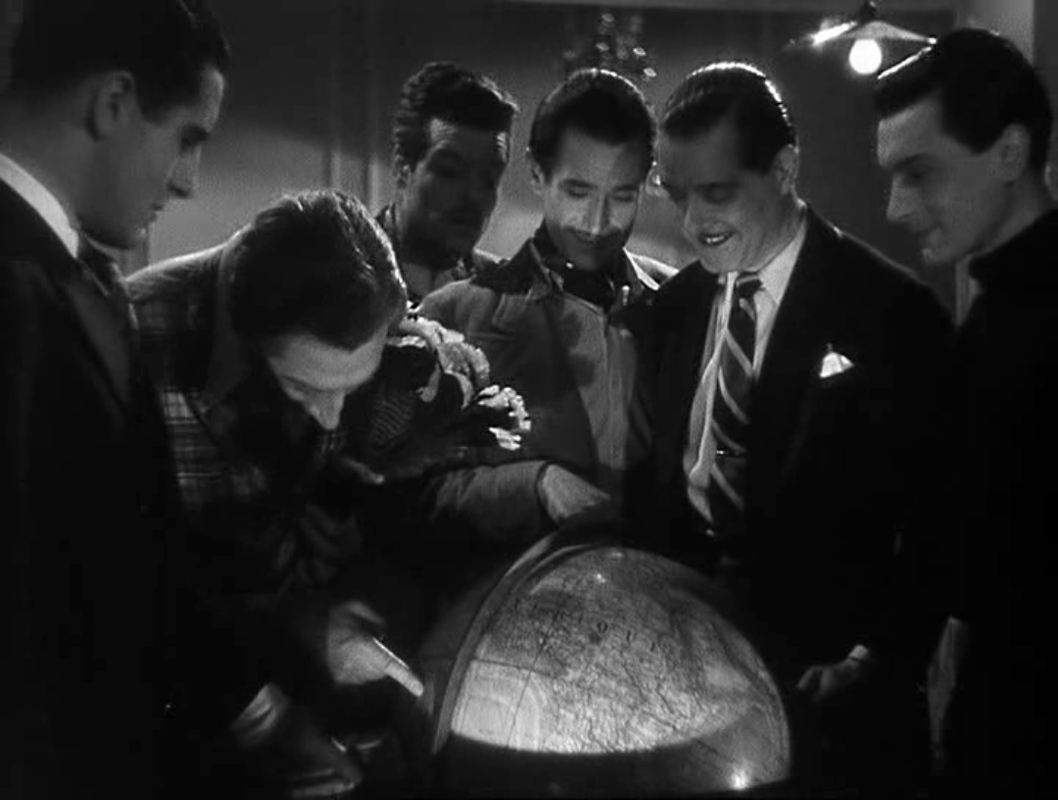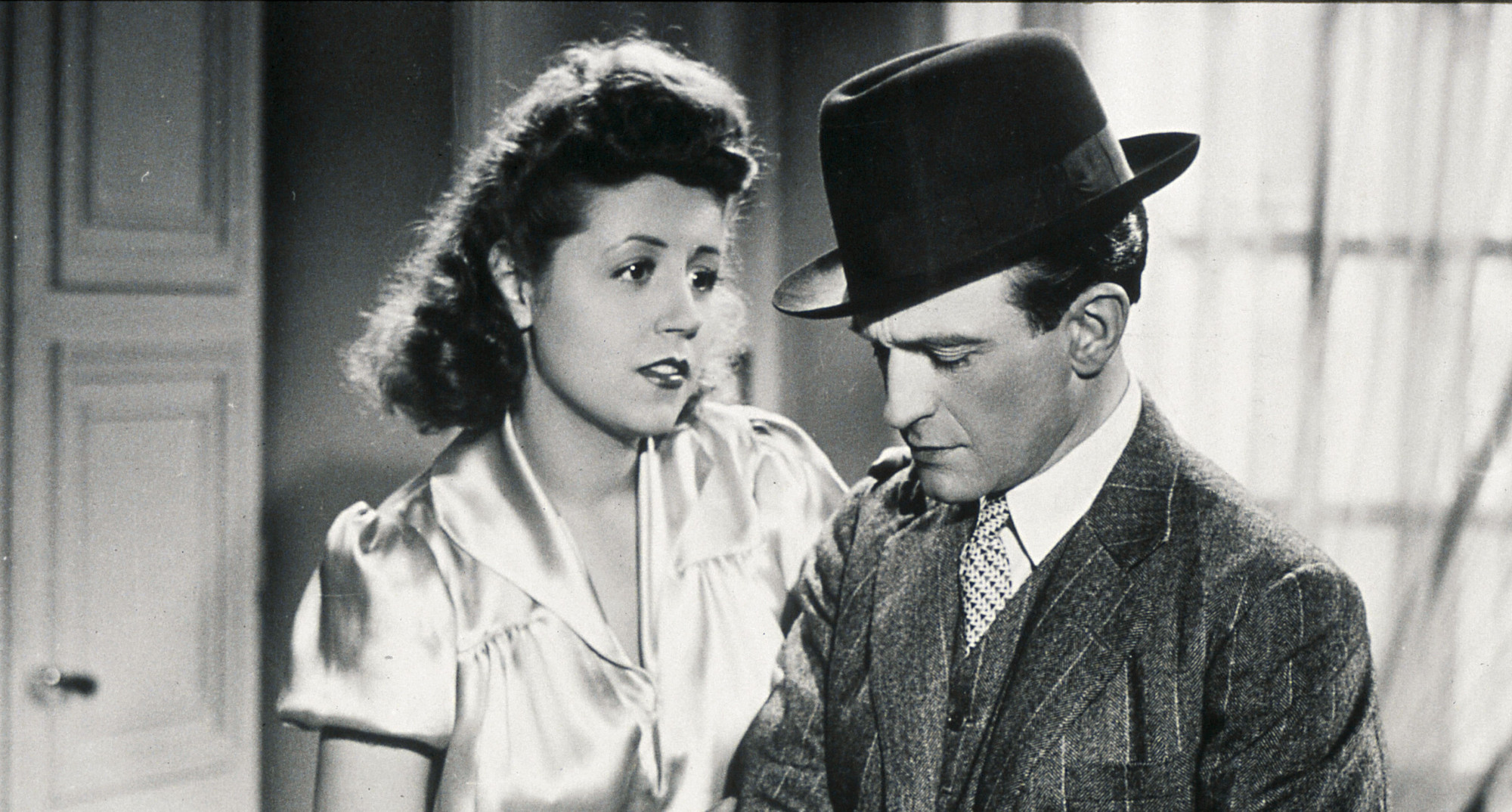LE DERNIER DES SIX(Continental Films / France / 1941)
A perfect example of how multiple adaptations of a single source material can be drastically different, yet each one highly-entertaining. This was the 3rd film version of Stanislas-Andre Steeman's "
SIX HOMMES MORTS" (Six Dead Men), following "
A STUDY IN SCARLET" (1933 / America) and
THE RIVERSIDE MURDER (England / 1935). I wondered if I was crazy for going after all 3, but I've enjoyed all 3 of them so much, I'm not the least bit sorry I did.
6 friends who made money betting together on the horse races decide to go their separate ways but sign a contract that whatever their fates, at the end of 5 years, they're all share the benefits equally. So of course, as the deadline approaches, and they gather together, suddenly, they start being killed off one by one. Someone at a site names "
French Films.com" implied this was a swipe of Agatha Christie's "
TEN LITTLE INDIANS", which was published in 1939, apparently unaware that the Belgian novel was published in 1931, which, if there was any swiping going on, would be on Christie's part!
The 3 films are so drastically-different in style and content, outside the central mystery plot. One scene they all have in common (which I was able to correctly predict), is when one of the friends is describing the murder of another, suggests one of them will kill off all the others, and then, suddenly gets shot while standing in a doorway. But a moment later, the body disappeared! Having seen the 2 earlier films already, I knew where this development was going. What I found interesting was how the witness to this shooting, Henre Senterre (played by Andre Luguet) while physically reminding me of a French version of Reginald Denny, also vaguely reminded me of actor Ian Fleming, who played the corresponding character in the 1935 version!
While Holmes in the 1933 film had no interest no women, and Inspector Winton in the 1935 film fell in love with a pushy newspaper reporter, Pierre Fresnay, as "Le commissaire Wensceslas Voroboevitch" (alias "Monsieur Wens") has a very hot-tempered actress girlfriend "Mila Malou" (played by Suzy Delair). She reminded me vaguely of Annie Potts, except with such an aggressively-abbrasive personality that I couldn't possibly tolerate her the way Wens does!
Early-on I realized this was the most lavish-looking, biggest-budgeted adaptation of this story so far. The house where the friends meet is a virtual palace, and the fancy music-hall looks like something out of a Hollywood musical, with a dance number in the later tradition of The June Taylor Dancers, and other woman standing around on the sides of the stage completely naked (I bet this film never passed The Hayes Office over here!).
The photography is also STUNNING. I would say this qualifies as "noir", everything seems to be in high-contrast dark & light, so many shadows everywhere, so such crisp, clean imagery. My Dad once spoke with admiration for German technical ability, lamenting their politics, and the Continental studio was entirely financed by the Nazis.
The highlight of the film, for me, was Commissioner Wens, who was quite an amusing, witty character. There were quite a few moments I found outright hilarious, but not without some effort, as the dialogue and English subtitles were going by so fast, I really had to pay attention to not get lost.
With all the inspiration and/or swiping going on between various authors and screen-writers, the ending of the film really caught my attention. Focused on a chase through an underground tunnel, the sequence reminded me an awful lot of a similar one in the 1962 Indian film "
BEES SAAL BAAD" (loosely adapted from Doyle's "
The Hound of the Baskervilles"), while the actual climax saw the murderer go down in quicksand just like from that book (a detail NOT in the '62 film).
I keep wondering if "
Six Hommes Mort" has been translated into English. It'd be interesting to know exactly how the book went, as compared to the film versions.
This was the 2nd DVD I got from "
Rare Films And More". Like the other one, the 1937 "
HOUND", it was on a DVD-R, with English subtitles, a somewhat-confusing menu, and a WW2-era newsreel as a bonus. This one, though narrated in German (I think) was done from The Allies' POV, as it consistently showed refugees from German's "barbarity" and stressed how The Allies (and The French in particular) were ready to drive back "The Hun". Considering the atrocities being committed worldwide right now by the USA, Watching this disturbing footage put me in a mood something like this might not have done decades ago.

The friends randomly choose where they'll each go to seek their fortunes.

Mila & Wens (It MUST be love-- how else could he put up with her?)

Wens & one of his top men, Picard.

Jean (a jealous and frustrated suitor) and Lolita.

Something The Hayes Office would object to.




